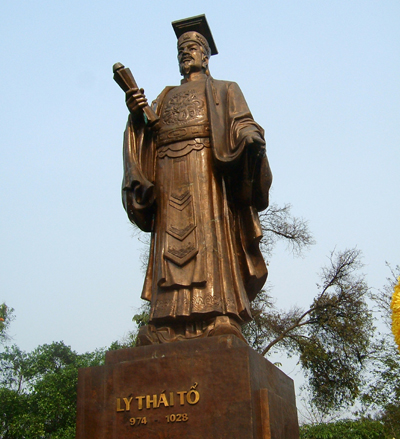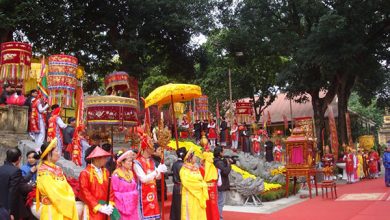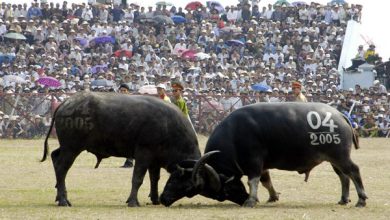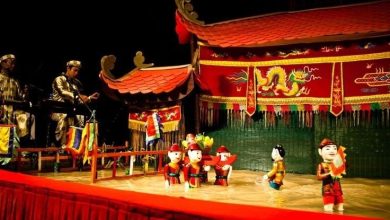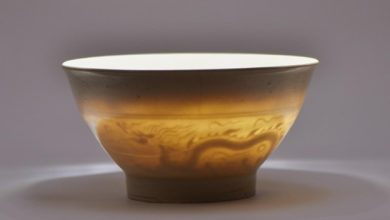986th death anniversary of Ly Thai To King kicked off
The 986th death anniversary of Ly Thai To King will be held at the Imperial Citadel of Thang Long- Hanoi on April 2, 2014 (March 3 of the lunar calendar).
Ly Thai To (974 – 1028) was the first King of the Ly Dynasty in Vietnam history. He reigned from 1009 to his death on 1028.
His birth name was Ly Cong Uan. He was born on February 12 in Giap Tuat year (equivalent to March 8, 974) in Dien Uan, Co Phap village (now Tu Son, Bac Ninh). He was originally the spiritual son of Buddhism. When he was 3 years old, his mother whose name was Pham Thi brough him to Luc To pagoda and asked Ly Khanh Van, head monk of the pagoda, to adopt. Later, he was put under the guardianship of the pagoda’s new headsmaster Van Hanh who early realized that “this boy was not a normal person; later he will certainly handle with problems and act as the lead”.
Being supported by Van Hanh, Ly Cong Uan came to the royal capital Hoa Lu to be the religious advisor for Le Dai Hanh King. He was gradually promoted from a minor official to a prominent post of the imperial government and was ultimately bestowed with the title “Tả thân vệ Điện tiền chỉ huy sứ” meaning “The Commander of the Palace’s Left Flank” at Le Ngoa Trieu dynasty (1005 – 1009).
On November 2 in Ky Dau year (equivalent to November 21, 1009), in Hoa Lu capital, Ly Cong Uan was enthroned to the post of King and establish the Ly dynasty.
After his ascension to the throne, Ly Cong Uan decided to relocate the imperial capital from Hoa Lu to Dai La. Edict on the Transfer of the Capital stated “… Dai La citadel, the former capital of Gao Wang, is in the very heart of the universe. The position evokes that of soaring dragon and stalking tiger, in the centre of the four directions, convenient for the development of the nation. This area is large and flat, high and bright, the population are not suffering from floods and darkness, everything is in full prosperity. After investigating all lands of Vietnam, this place is actually the gathering venue of people from across the nation, the most appropriate place for eternal capital positioning.…”
According to the Complete Annals of Dai Viet, “The King relocated the capital from Hoa Lu to Dai La in the autumn in July. While boats temporarily anchored by the citadel (Dai La), a golden dragon appeared on the royal boat, consequently it was renamed Thang Long citadel”.
The decision on relocation of the capital and establishment of new capital in Thang Long was a significant event, marking the outstanding development of Ly dynasty and Dai Viet.
The Dai Viet in the Ly dynasty quickly became an independent, united, powerful and prosperous country in the Southeast Asia, where Thang Long was the largest political, economic and cultural centre of the country, when the national culture was gathered and creamed.
According to Ngo Si Lien, a historian under the Le dynasty, Ly Thai To “received profoundly and quietly destiny, relocated the capital, directed the heart to people and country; eliminated the enemy, unified the North and the South; brought about the peaceful world and long-term demise. It was the plan and strategy of the King” (Complete Annals of Dai Viet).
Ly Thai To died in 1028 at the age of 55 according to the royal official accounts. He was buried at “Thọ Lăng” meaning the Mausoleum of Longevity, outside of Thien Duc Palace. His designated regal name was “Thái Tổ” meaning “The Supreme Forefather”, his posthumous imperial title was “Thần Vũ Hoàng đế” meaning “The Revered Martial Emperor”.
Thang Long- Hanoi Heritage Conservation Centre

